Our Mt. Shasta Forest Pond, McCloud - 2015
Kathy's Dragonfly Roost Pond Diary
February (click any small image to see it in an expanded view)
We were able to visit our McCloud home and pond in February, but, brr, it was cold, pretty, but cold.
And, NO SNOW!! There should have been LOTS of snow - all we had was ice on the pond. Below is a photo captured
by the our trail cam. No animals showed on it, but a bird must have set it off. The designs the ice makes on the snow were gorgeous,
but this 4th year of drought is getting scary. Even Mt. Shasta was showing bare ground in places. But her pink glow at dawn
still was pretty.
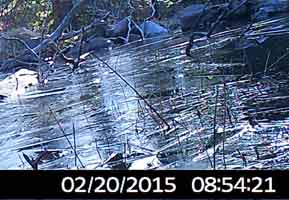
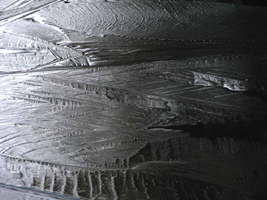
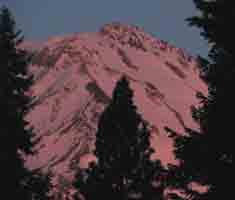
March (click any small image to see it in an expanded view)
We were able to come back up for a week in March. STILL NO SNOW!! And, our deer showed up in their winter coats....usually they don't
show up until June! Yikes!! But we certainly enjoyed their company (the place truly seems empty when they are gone!). In the summer,
they wear gorgeous reddish coats, but in March they had their shaggy gray coats on.
But then, cruel trick on the deer, it snowed - a couple of feet!! At first the warmth of the pond kept it open,
but day after day it snowed.
When we left, the snow had stopped, where the deer were, we didn't know.
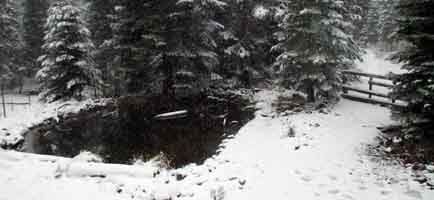
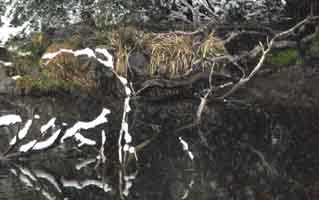
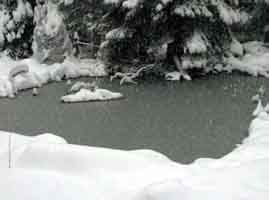
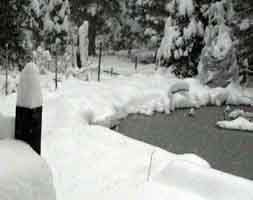
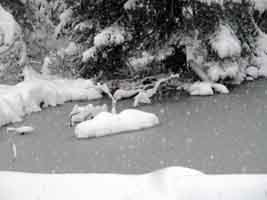
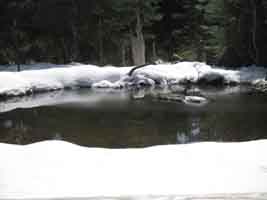
April (click any small image to see it in an expanded view)
We actually didn't get up to our McCloud home in April, but when we arrived in May, we found images on our trail cam,
taken in April, that I want to share:
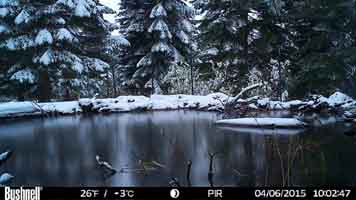
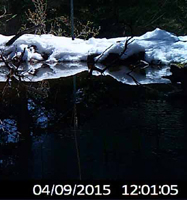
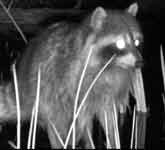
This was the first 'proof' of a raccoon. Since then, the camera has told it's tale, the raccoon visits about every 2 weeks.
May (click any small image to see it in an expanded view)
The trail cam also had some interesting photos from earlier in May- Shaggy deer in a row (wonder if they were all bucks, hard
to tell when they don't have their antlers); a visit from a Band-tailed Pigeon, and then the Accipter type of hawk. I so wanted it tobe
a Goshawk (they are rare and mountain specialists) but when I shared the photos with some expert Hawkers, well, it is 'only' a Cooper's Hawk.
Accipters are specialists on hunting other birds as their prey.
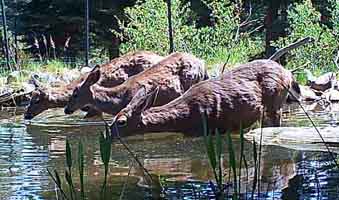
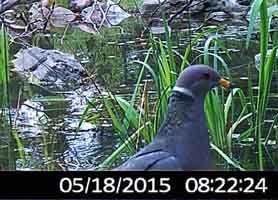
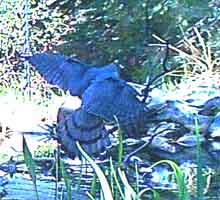
We really LOVE having a trail cam on the pond. It shows us things we don't see, esp. at nite and when we're not there. And
I can always hope for a Cougar or ?????
But let's get back to real time photos.... I was able to come up twice in May as my friend Nancy loves it up there too.
We love documenting what we find at both our homes. This next image is of a Stonefly (with the pond in the background). It was
on the glass sliding door. And the Hermit Thrush returned on the 8th. He may wear drab clothing, but his
song is heavenly
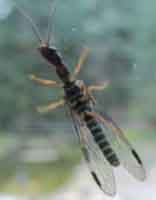
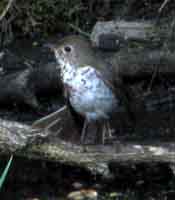
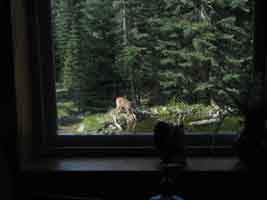
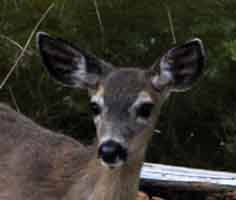
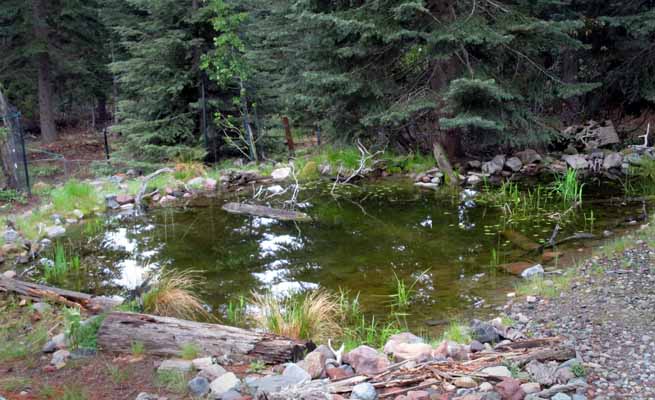
It rained hard every afternoon, but when the sun showed itself, Nancy and I were delighted to be able to watch a 12-spotted Skimmer
(Libellula puchella) emerge. We spent over an hour recording this event....I'm giving it its own page, so click on either of
its images below
to see the transformation: This is how a dragonfly makes the transistion from an underwater
nymph breathing thru gills to an air-breathing flying insect...all in an hour's time!
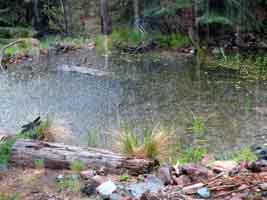
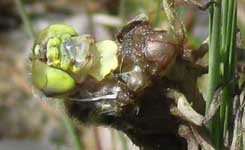
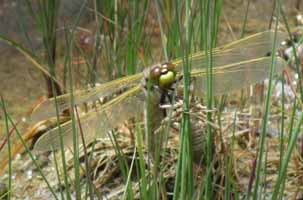
It was hard to leave with everything that was going on....but I knew I'd be back soon with Dave.
June & July (click any small image to see it in an expanded view)
When we did return, as usual, one of the first things we did was check the trail cam. Here's what it showed us:
The raccoon was back, almost exactly a month after his last visit, and indeed, a member of the visiting group of deer wanted to
be certain that we noticed that he was growing antlers! We get such a kick out of it when the animals seem to take 'selfies'!!
Of course, we were secretly hoping to see the bear again!!
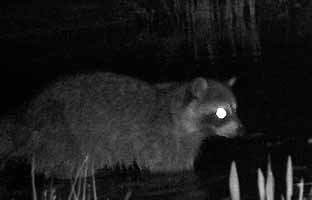
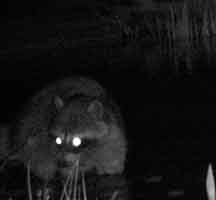
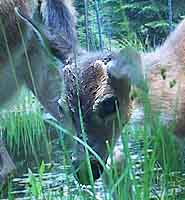
It was wonderful when we finally arrived for the summer during the first week of July to find, even in this 4th year of drought,
that my pond plants were thriving, even some of the ones that hadn't been before! And all this in our absence!! The way we have
the pond set up is that our well pumps water into a 2400 gallon tank. From the bottom of the tank
we have a timer set up. It allows water to flow thru a buried line that leads to the pond, for 20 mins a day. As the amount of water in the tank lowers,
the water pressure lessens. But it is still enuf to keep the pond full, or close to it, for up to a month's time without our being there, even when we
don't have rain. Then, we have our plants either planted IN the pond, or very adjacent to it.
When the pond is full, the water leaches out to water the plants in our absence. The pond is in chaparral, so very dry otherwise.
ALL our plants are native to Siskiyou County, CA, where this pond is located. One of the plants whose growth really took off this
year was the Water Shield (Brasenia schreberi) . We found it growing at Orr Lake. It's size is much more appropriate for a garden pond than our native
Waterlily, which has HUGE leaves. Both plants have roots at the bottom of the pond and leaves that float on the surface. But Water
Shield's leaves have the stem come up in the very center (underside) of the leaf.
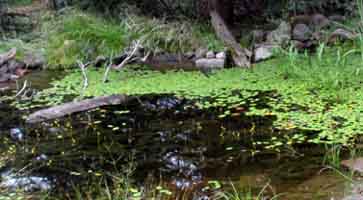
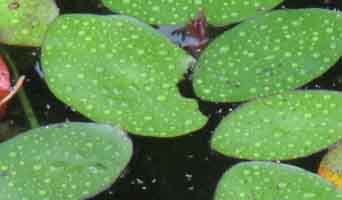
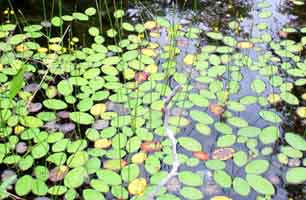
Another plant that just went crazy this year was Common Bladderwort (Utricularia vulgaris). It had just been growing in the shallows, but now it's growing
all over the pond, and blooming!! BUT, YIKES!! I thought it was providing a wonderful substrate for our critters and I just read
that its CARNIVOROUS!! Maybe I'll be removing most it!!
For the very first time ever, our Pondweed (Potamogeton natans) bloomed, and the
Showy Milkweed (Asclepias speciosa) - it grows just outside the pond, went crazy!!
And the stems of the Water Plantain (Alisma plantago-aquatica) were covered in exuviae - that means that LOTS of dragonflies were using it to emerge upon!
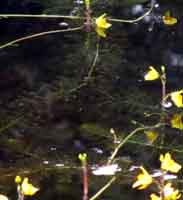
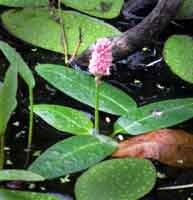
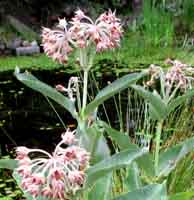
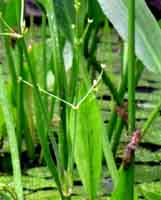
Our first fawns were caught on the trailcam on the 14th - a pair of twins! I've read that a doe has a singleton her first pregnancy,
and thereafter she has twins. These two were curious about the water, but not willing to try it yet. But the next image shows a
creature that MUST 'try' the water. These 2 Pacific Forktails are in the 'wheel position' - which means they are mating. ONLY the
Odonata (dragonflies and damselflies) mate in this unique position. Next the female will begin laying eggs by inserting them into
the plant stems and leaves that are floating on the water. The 3rd image is the female alone, perhaps contemplating where to put those
eggs - they will be fertiziled just as they leave her body, passing thru the sperm mass that the male has inserted.
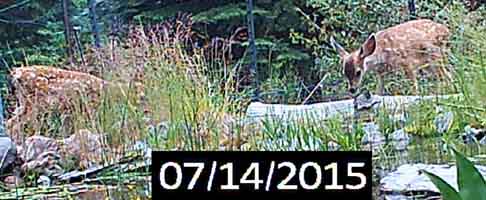
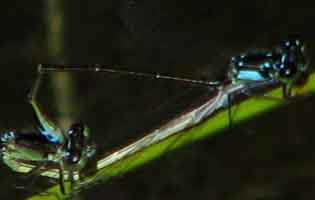
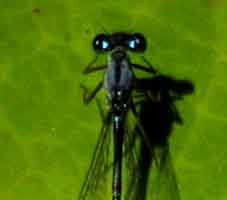
The first image below in this set was new to our pond, and it is our 18th species of Odonata to visit. It's either a male Northern or Boreal Bluet. You must have them in-hand to tell them apart.
Two other rarities that visited were a Townsend's Solitate, not rare in the county, but a bird we seldom see, and a Cardinal Meadowhawk. The Cardinal is the most common
dragonfly at our Sebastopol Bigsnest Pond, but it's a rare treat up here. The species is named after the bird the Cardinal, which is
named after the Catholic Cardinals with their pointed hats. Both species stayed but only one day.
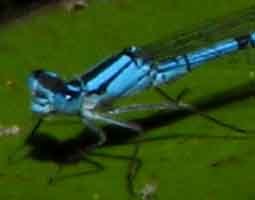
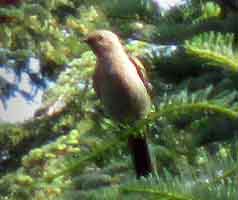
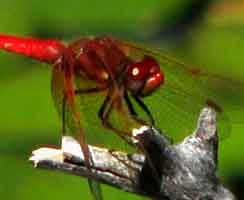
Then we had a 'rash' of critters taking 'selfies' on the trailcam! First it was none-other than the Cooper's Hawk;
then one of the fawns got into the act; his mom then wanted to see what the fuss was about; and then in came another fawn!!
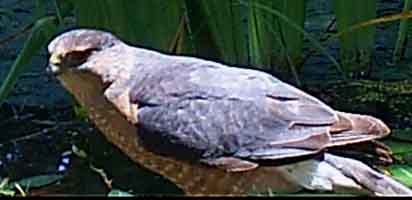
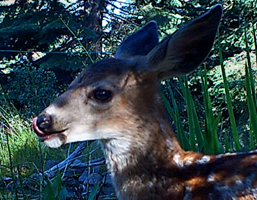
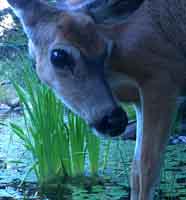
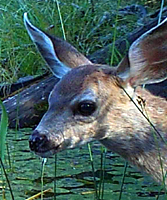
Thereafter, the "in" thing was, well, to be IN the pond, inc. this fawn, froglet and Yellow Jacket.
Embarrassingly, we found that the trail
cam even 'spied' upon some of the pond's admiring guests!!
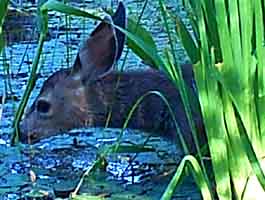
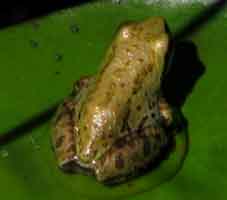
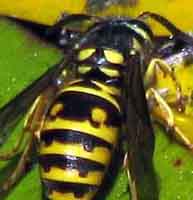
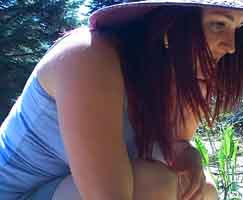
All month long we were visited by the does, fawns and bucks. We esp. enjoyed wathching as the buck's antlers grew in.
We come to think of them as, well, neighbors, and they are indeed! Nice and quiet most of the time too. Click on the mosaic to see
a page of our gorgeous, quiet neighbors. We esp. enjoy them, compared to some pot growers who have shown up in the area. These shots
include a fight between 2 does and an uncle checking out his new niece!!

Then, on the 21st, we had a storm like no other storm before - it started with hail the size of grapes. After 3 hrs, we'd had
more than SIX INCHES of rain. It really shedded the plants, even those in the pond, but the overflow worked just fine.
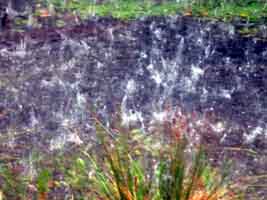
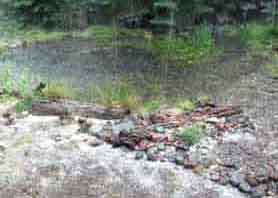
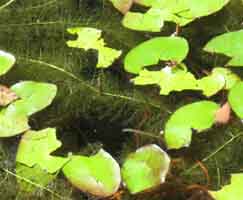
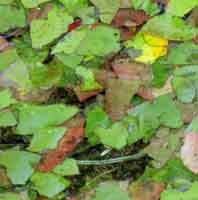
We worried about how our critters did, as there was a LOT of flooding and some homes and many roads were damaged, so we were glad
to see the deer and birds return the very next day. In fact, that one doe seems to be saying, "See!! I'm AOK!!" In fact, a Chipping
Sparrow made its first appearance of the year!
And we were (barely) able to record our Brown Creeper for the first time!
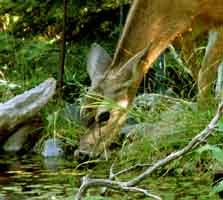
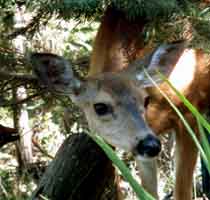
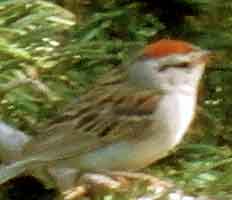
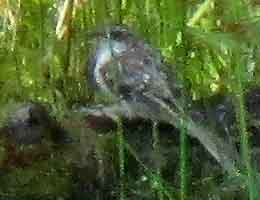
Wow, so many wonderful memories from our pond in July! Since we are in chapparal, water is greatly appreciated. Sometimes we can just
spend hours watching the pond. Here are some of our other avian visitors. The male Western Tanager is always a treat...and we have several
so we see them frequently. But the Black-throated Gray Warler is an infrequent visitor and we're always excited to see it.
And although they can be common at our Sebastopol yard, the Bushtits are always a delight as they come in as an excited throng and just gush about.
Another 'wow' bird is the Herit Warbler. They too nest on the property and we see these birds with their brillantly marked heads
almost daily, if not several times a day.
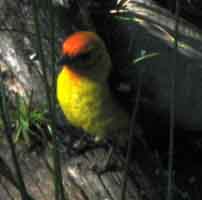
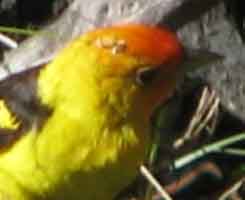
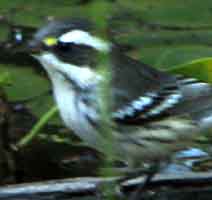
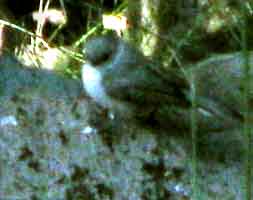
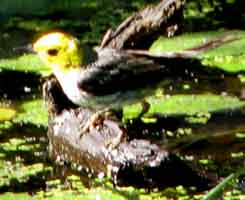
Under construction, please check back again soon!!
end




























































